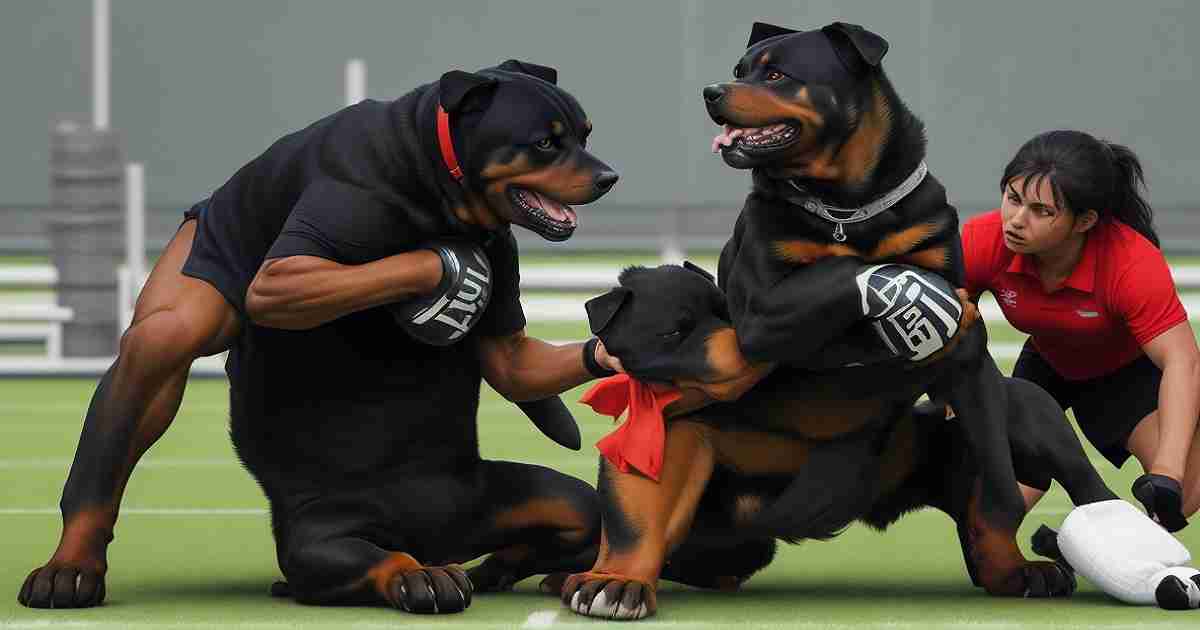Have you ever wondered what goes into training a Rottweiler to attack? As the owner of one of these powerful, muscular dogs, you may have considered whether attack training is right for your Rottie.
Rottweilers have a number of traits that make them suitable for protection work:
- Strong guarding instincts
- Loyalty and willingness to defend owners
- High intelligence and trainability
- Strong bite force and athleticism
However, Rottweiler attack training is a complex process that requires time, dedication, and careful precautions. This comprehensive guide will explore:
- The foundation obedience and control needed
- Core commands like “bark,” “hold,” and “release”
- Drives and targeting work
- Safety measures and legal risks
We’ll also answer common FAQs about training a Rottweiler to attack, like:
- What age is best to start?
- What equipment is required?
- How long does it take?
While attack training can be rewarding for some owners, it also carries serious risks and responsibilities. We’ll outline important ethical considerations as well.
By the end, you’ll have a complete understanding of Rottweiler protection training – both the how-to and the need-to-know. Let’s get started!
How’s this? I aimed to highlight important keywords in bold, break up longer sections, and keep an engaging, conversational tone. Let me know if you’d like me to modify or expand the introduction.
Establishing a Solid Foundation
Before you even think about Rottweiler attack training, you need to spend time building a foundation of obedience and control. Without proper groundwork, you risk creating an unbalanced and dangerous animal.
Obedience Training
Formal obedience training should begin the moment you bring home your Rottweiler puppy. Focus on commands like:
- Sit
- Stay
- Come
- Heel
- Down
Reinforce these with positive rewards like treats, praise, and play. Be firm and consistent – Rotties are strong-willed and will test boundaries.
Rottweiler attack training requires an extensive obedience skillset. Your dog must:
- Follow commands immediately in any environment
- Ignore distractions around them
- Look to you for guidance and permission
Practice obedience commands daily to ingrain habits. Don’t progress to defense training until your Rottweiler demonstrates solid responsiveness and impulse control.
Socialization
Socialization goes hand-in-hand with obedience. Expose your Rottweiler puppy to a wide range of:
- People (ages, appearances, behaviors)
- Animals (dogs, cats, livestock)
- Places (parks, stores, vehicles)
- Noises (sirens, crowds, construction)
The goal is to build confidence and ensure your Rottweiler can ignore stimuli that aren’t a real threat. A well-socialized dog is less likely to misinterpret triggers or overreact.
Establishing Respect
While socializing your dog, also establish yourself as the clear leader. Rottweilers respect strong authority figures.
- Use a firm, calm voice when giving commands
- Don’t let your Rottweiler get away with disobeying
- Set household rules and enforce them
Attack training requires your Rottweiler to look to you for when and how to act aggressively. You must have an authoritative relationship built on respect.
With this strong foundation in place, you can move on to the specialized commands needed for protection work. Never skip these critical first steps when training a Rottweiler to attack!
How’s this section? I aimed to highlight keywords, use bullet points for scannability, and keep an engaging tone suitable for a conversational blog post. Please let me know if you would like me to modify or add anything!
Teaching the Core Attack Skills
Once your Rottweiler has obedience and socialization mastered, you can move on to specialized protection training. This is where you teach the core skills needed for your dog to attack on command.
Building Drive
Rottweilers have strong prey drive and defense drive instincts. You need to tap into these drives to train effective protection behaviors.
Use toys and games to stimulate your Rottweiler’s prey drive. Let them chase and “kill” things like balls, tugs, and flirt poles. Reward with lots of praise.
For defense drive, use simulated threats like loud noises, privacy invasion, and harmless “attacks.” Get your Rottweiler riled up and wanting to defend their territory.
With both drives engaged, your dog will be eager and ready for Rottweiler attack training.
Targeting
Start by teaching your Rottweiler to attack specific targets on cue:
- Present a pillow and say “Get it!” When they bite, reward with praise.
- Hold a towel and give the attack command. Trade for a toy when they grab the towel.
Gradually increase the complexity of the targeting. This trains them to strike exactly what you indicate, building control.
Introduce the Sleeve
The sleeve is a padded training tool used to teach biting. Have your helper wear the sleeve and provoke your Rottweiler’s defense drive.
When your dog is worked up, give the attack command while directing them towards the sleeve. Let them bite firmly, then trade for a reward.
Use the sleeve for bite development and teaching the out or release command. This prepares them for Rottweiler attack training using human “threats.”
Core Commands
Teach these essential commands using positive reinforcement:
Bark: Barking intimidates intruders. Have your dog bark on cue.
Hold: Grip the sleeve firmly without readjusting. Builds control.
Attack: Strike the target when commanded.
Out/Release: Let go of the sleeve on cue.
Train these skills extensively before moving to scenarios with human decoys. Correct technique is crucial when training a Rottweiler to attack.
How’s this section? I aimed to highlight keywords, incorporate bullet points for easy skimming, and use an engaging, conversational tone suitable for a blog post. Please provide any feedback on improving or expanding this draft.
Prioritizing Safety
While the training process can be rewarding, Rottweiler attack training requires caution and care. Let’s discuss best practices for control, legal considerations, and ethical use.
Safety Measures
Protection dogs require extensive oversight to prevent accidents:
- Keep your Rottweiler confined or leashed when not training
- Muzzle them in public and around strangers
- Closely supervise all interactions with new people
- Ensure a strong “out” cue before real-world biting
Take precautions, but remember that management, not punishment, is key. Never compromise trust through harsh corrections.
Maintaining Control
Even highly trained protection dogs have instincts to defend themselves. To maintain control:
- Refresh obedience commands frequently
- Quickly correct unwanted aggression
- Socialize them continuously to reinforce temperament
- Watch for signs of stress and instability
Avoid situations where your Rottweiler feels the need to take matters into their own paws. They should always look to you for guidance.
Legal and Ethical Risks
– Training a Rottweiler to attack has serious liabilities if misused. Many places prohibit owning attack dogs.
Ethically, only consider protection training if absolutely necessary for your lifestyle. Never put others at risk or glorify aggression. Your Rottweiler’s skills should only be used for legal defense in true emergencies.
How’s this section? I focused on addressing risks and best practices when training a Rottweiler for protection work, using a conversational yet professional tone. Please provide any feedback!
Final Takeaways for Rottweiler Attack Training
We’ve covered a lot of ground on training a Rottweiler to attack. Here are some final tips to recap:
- Have realistic expectations about the commitment required. This is an intensive, long-term investment.
- Be patient and consistent with training. Take it slow and don’t skip foundations.
- Consider alternative options like schutzhund sport training if you don’t need a real protection dog. The risks of attack training are high.
- Always prioritize safety and ethics first. Never put your Rottweiler or others in harm’s way.
- Ongoing socialization and obedience practice is vital. You must maintain control at all times over a protection trained dog.
Rottweiler attack training has serious liabilities, but can also forge an incredible bond if done correctly. Put in the work to ensure you have both a confident guard dog and a happy companion.
Thanks for reading! We covered everything from foundations to specifics on teaching a Rottweiler to attack. Please contact me if you have any other questions.
How’s this for a final summary section? Let me know if you would like me to modify or expand on anything.
FAQs About Training a Rottweiler to Attack
Let’s cover some common questions about teaching your Rottweiler to attack:
What Age Should I Start Attack Training?
Wait until your Rottweiler is at least 18-24 months old before beginning protection work. Their drives won’t fully develop until physical maturity.
Focus on foundational obedience and socialization as a puppy and adolescent. When they reach adulthood, they’ll be ready for more intense Rottweiler attack training.
What Equipment Do I Need?
Essential equipment includes:
- Leashes and collars: Use a thick leather or nylon slip lead for maximum control
- Muzzle: For safety when in public and around strangers
- Bite sleeve: Padded sleeve worn by the decoy to teach biting
- Toys: Balls, tugs, pillows, etc. to build drive
Invest in high-quality supplies designed specifically for protection dog training. Don’t improvise with everyday household items.
Is Attack Training Safe for Rottweilers?
With the right precautions, oversight, and training approach, teaching a Rottweiler to attack can be done safely. However, there are always inherent risks when dealing with powerful breeds.
Rottweiler attack training should only be pursued by experienced owners committed to maintaining control. It’s not to be taken lightly.
Can Female Rottweilers Be Taught to Attack?
Yes, female Rottweilers can absolutely be trained for protection work!
Sex has little bearing on a Rottweiler’s ability to learn attack commands, develop aggression, and guard. Raise, socialize, and train females the same as males.
How Long Does Rottweiler Attack Training Take?
Expect the full process to take 1-2 years from start to finish. You’ll need many hours of dedicated repetition and skill development.
Build a solid obedience foundation first. Then begin defense drive stimulation and bite development. With maturity and experience, your Rottweiler will perfect its attack skills.
Be prepared for an intensive long-haul commitment when training your Rottweiler to bite and protect. But the payoff in companionship can be immensely rewarding.
Let me know if you need any clarification or have additional FAQs to address! I aimed to provide comprehensive answers while engaging readers.









1 thought on “Training a Rottweiler to Attack: A Complete Guide for Owners”